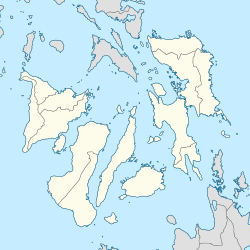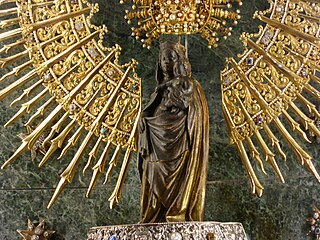
Our Lady of the Pillar is the name given to the Blessed Virgin Mary in the context of the traditional belief that Mary, while living in Jerusalem, supernaturally appeared to the Apostle James the Greater in AD 40 while he was preaching in what is now Spain. Those who adhere to this belief consider this appearance to be the only recorded instance of Mary exhibiting the mystical phenomenon of bilocation. Among Catholics, it is also considered the first Marian apparition, and unique because it happened while Mary was still living on Earth.

As part of the worldwide Catholic Church, the Catholic Church in the Philippines, or the Philippine Catholic Church, is part of the worldwide Catholic Church, under the spiritual leadership of the Pope in Rome. The Philippines is one of the two nations in Asia having a substantial portion of the population professing the Catholic faith, along with East Timor, and has the third largest Catholic population in the world after Brazil and Mexico. The episcopal conference responsible in governing the faith is the Catholic Bishops' Conference of the Philippines (CBCP).

The Archdiocese of Zamboanga is a Catholic archdiocese in the Philippines. Its present jurisdiction includes Zamboanga City, with suffragans in Basilan, Zamboanga Sibugay, and the Apostolic Vicariate of Jolo. It became Mindanao's first diocese in 1910, and was established as the second archdiocese of Mindanao in 1958. Today, the archdiocese covers a land area of 1,648 square kilometers and has a population of 442,345, of which 81 percent are Catholics. The archdiocese includes 28 parishes and one quasi-parish, served by 57 diocesan and 18 religious priests. There are also 51 religious sisters working in the archdiocese.

The Real Fuerte de Nuestra Señora del Pilar de Zaragoza, also Fort Pilar, is a 17th-century military defense fortress built by the Spanish colonial government in Zamboanga City. The fort, which is now a regional museum of the National Museum of the Philippines, is a major landmark of the city and it symbolize the cultural heritage.

The Cathedral Parish of Saint Andrew, also known as the Diocesan Shrine of Nuestra Señora del Buen Suceso and commonly known as Parañaque Cathedral, is one of the oldest Roman Catholic churches in the Philippines, located in Parañaque City, Metro Manila. Established on May 11, 1580 by the Spanish Augustinians, it is, at present, the seat of the Diocese of Parañaque, which comprises the cities of Parañaque, Las Piñas, and Muntinlupa.
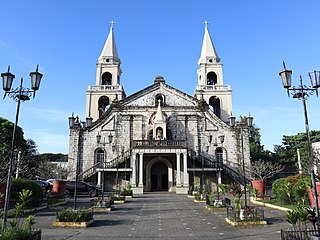
The National Shrine of the Our Lady of Candles, also known as the Metropolitan Cathedral of Saint Elizabeth of Hungary and colloquially as Jaro Cathedral, is a cathedral located in the district of Jaro in Iloilo City, on the island of Panay in the Philippines. The seat of the Roman Catholic Archdiocese of Jaro, it was placed under the patronage of Saint Elizabeth of Hungary. It was established in 1575 as a visita (chapel-of-ease) of Oton by the Augustinians and as a separate parish in 1587. The present-day structure of Jaro Cathedral was built in 1874.
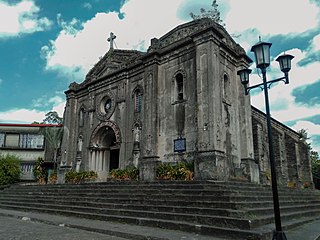
The Nuestra Señora de Gracia Church, commonly known as Guadalupe Church, is a Baroque Roman Catholic church in Makati City, Philippines. The parish church and its adjacent monastery are currently administered by the Archdiocese of Manila. The territory of the parish covers San Carlos Seminary, the major seminary of the Archdiocese of Manila and Our Lady of Guadalupe Minor Seminary. The church also has an adjacent seminary, the Monasterio de Guadalupe, which admits young professionals for priestly and religious vocation. The current parish priest is Rev. Fr. Joselito R. Martin.
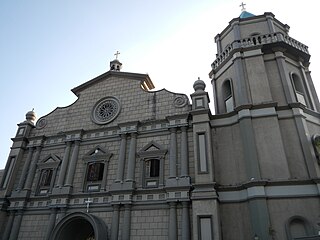
The Minor Basilica and Shrine Parish of Our Lady of the Rosary of Orani, commonly known as Orani Church, is a Roman Catholic minor basilica built in the Neoclassical style located in the center of Orani, Bataan, in the Philippines. It is under the jurisdiction of the Diocese of Balanga.
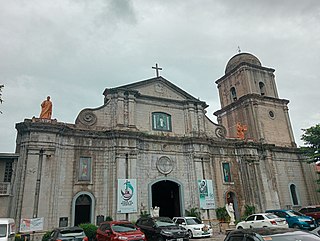
The Diocesan Shrine and Parish of Our Lady of the Pillar, commonly known as Imus Cathedral, is a Roman Catholic cathedral church in the city of Imus, in the province of Cavite, Philippines. The church serves as the seat of the bishop of the Diocese of Imus, the diocese that has jurisdiction over the entire Civil Province of Cavite.

The National Shrine of Our Lady of the Abandoned, also known as the Santa Ana Church, is a Spanish colonial period church located in the district of Santa Ana in Manila, Philippines. The parish was established by the Franciscan missionaries in 1578 under the patronage of Saint Anne. The present stone church was constructed by Vicente Inglés from 1720 to 1725 and was dedicated to its present patron, the Our Lady of the Abandoned. The revered image of its patron was made in Valencia, Spain in 1713 and arrived in the Philippines in 1717.

The Archdiocesan Shrine of the Blessed Sacrament, also known as the Our Lady of the Pillar Church or simply the Santa Cruz Parish, is a Mission Revival Roman Catholic parish church in the district of Santa Cruz, Manila, Philippines. It was built when the arrabal (suburb) of Santa Cruz was established by the Jesuits in the early 17th century. The church had undergone many repairs and reconstruction, with the last reconstruction done in the 1950s.

The Immaculate Conception Parish Church is the oldest Roman Catholic church in the municipality of Los Baños, Laguna, Philippines. Its titular is the Nuestra Señora del Aguas Santas and its feast is celebrated every December 8. The church is under the jurisdiction of the Diocese of San Pablo.
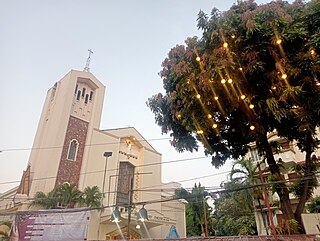
Sampaloc Church or the Archdiocesan Shrine of Our Lady of Loreto is a Roman Catholic Church located along Figueras Street in the district of Sampaloc in the City of Manila. The church is named after and dedicated to the Virgin Mary and her pilgrimage site in Loreto, Italy where tradition states as the site where the Mary's house was relocated.

Immaculate Conception Parish Church, also known as La Purisima Concepcion de la Virgen Maria Parish Church and Baclayon Church, is a Roman Catholic church in the municipality of Baclayon, Bohol, Philippines within the jurisdiction of the Diocese of Tagbilaran. Baclayon was founded by the Jesuit priest Juan de Torres and Gabriel Sánchez in 1596, and became the oldest Christian settlement in Bohol. It was elevated as a parish in 1717 and the present coral stone church was completed in 1727. The Augustinian Recollects succeeded the Jesuits in 1768 and heavily renovated the church since then.

The Nuestra Señora de la Luz Parish Church, also known as Our Lady of Light Parish Church and commonly as Loon Church, is a Roman Catholic parish church in the municipality of Loon, Bohol, Philippines, under the Diocese of Tagbilaran. The parish was established by the Jesuits in 1753 and the original stone church was built from 1855 to 1864. It was declared as a National Historical Landmark by the National Historical Commission of the Philippines and a National Cultural Treasure by the National Museum of the Philippines.

The Nuestra Señora del Pilar Parish Church, also known as the San Simon Church, is a 19th-century Baroque Roman Catholic church located at Barangay San Juan, San Simon, Pampanga, Philippines. The parish church, under the protection of its patron saints, the Virgin of the Pillar and Saint Peter, is under the Archdiocese of San Fernando.

The Archdiocesan Shrine of Patrocinio de Maria Santisima, commonly known as Boljoon Church, is a Roman Catholic church dedicated to Our Lady of the Patronage in the municipality of Boljoon, Cebu, Philippines, under the Archdiocese of Cebu.
Philippines National Historic Landmarks is a registry of historic sites in the Philippines that have been officially declared by the Philippine Registry of Cultural Property.

San Guillermo de Aquitania Parish Church, commonly known as Dalaguete Church, is a Roman Catholic church located in Dalaguete, Cebu, Philippines. Dedicated to the French saint William of Gellone, also known as William of Aquitaine, it is under the jurisdiction of the Archdiocese of Cebu. The church was constructed in 1802 and was completed in 1825.


